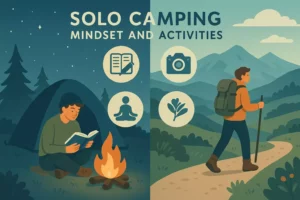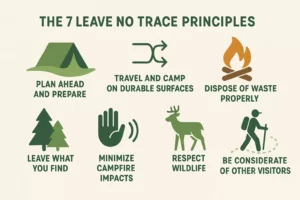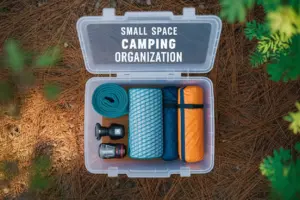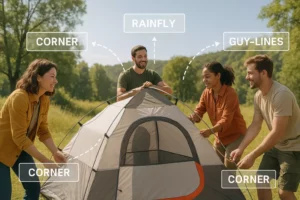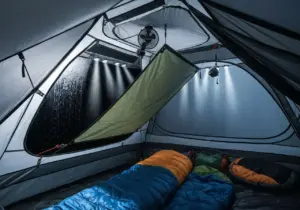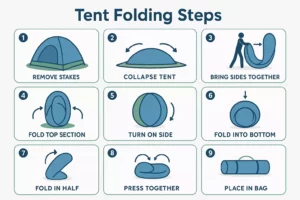Building the Ultimate Bushcraft Survival Kit for Camping in 2025
Picture this: you’re deep in the wilderness, miles from civilization, when unexpected weather rolls in or your planned route becomes impassable. In moments like these, a well-assembled bushcraft survival kit becomes the difference between a memorable adventure and a dangerous situation. Unlike standard camping gear, bushcraft survival equipment focuses on versatility, durability, and the ability to help you thrive using nature’s resources.

Key Takeaways
- Essential bushcraft tools include a fixed-blade knife, fire starter, cordage, and shelter materials as your core survival foundation
- Weight and versatility matter more than quantity – choose multi-purpose items that serve multiple functions in wilderness situations
- Practice with your gear before heading into the wilderness to ensure familiarity and confidence during emergencies
- Layer your kit by skill level, starting with basic essentials and adding advanced tools as your bushcraft knowledge grows
- Regular maintenance and updates keep your survival kit reliable and ready for any outdoor adventure
Understanding Bushcraft vs. Traditional Camping Gear
Bushcraft survival kits differ significantly from standard camping equipment. While traditional camping gear focuses on comfort and convenience, bushcraft tools emphasize self-reliance and resource utilization. These kits help you work with natural materials to create shelter, find food, purify water, and maintain warmth.
The philosophy behind bushcraft centers on minimal impact and maximum adaptability. Instead of carrying a heavy tent, bushcraft enthusiasts learn to build shelters using tarps and natural materials. Rather than packing multiple single-use items, they choose tools that serve various purposes.
Core Principles of Bushcraft Survival
🔥 Fire – Creating and maintaining fire for warmth, cooking, and signaling
🏠 Shelter – Protection from elements using minimal gear and natural resources
💧 Water – Finding, collecting, and purifying water sources
🍃 Food – Foraging, hunting, and preserving natural food sources
🧭 Navigation – Moving safely through wilderness without GPS dependency
Essential Components of Your Bushcraft Survival Kit

The Big Four: Non-Negotiable Survival Tools
1. Fixed-Blade Knife 🔪
A high-quality fixed-blade knife serves as your most important tool. Choose a blade between 4-6 inches with a full tang construction for maximum durability.
Key Features to Look For:
- Carbon or stainless steel blade
- Comfortable grip in wet conditions
- Thick spine for batoning wood
- Sharp point for detailed work
2. Fire Starting Kit 🔥
Reliable fire creation requires multiple methods. Pack at least three different fire-starting tools:
- Ferro rod with striker
- Waterproof matches in sealed container
- Lighter with backup fuel
- Tinder bundle (birch bark, char cloth, or commercial tinder)
3. Cordage and Rope 🪢
Paracord (550 cord) provides incredible versatility for shelter building, gear repair, and emergency situations. Pack at least 50 feet, but 100 feet offers more options.
Additional Cordage Options:
- Bank line for fishing and snares
- Duct tape wrapped around trekking poles
- Wire for emergency repairs
4. Shelter Materials 🏕️
A quality tarp weighing 1-2 pounds can create numerous shelter configurations. Choose ripstop nylon or canvas with reinforced grommets.
For those interested in larger group camping scenarios, understanding basic shelter principles helps in any situation.
Water Procurement and Purification 💧
Water safety remains critical in wilderness survival. Your kit should include multiple purification methods:
| Method | Weight | Effectiveness | Best Use |
|---|---|---|---|
| Water filter | 2-4 oz | Removes bacteria/parasites | Clear water sources |
| Purification tablets | 1 oz | Kills most pathogens | Emergency backup |
| Metal container | 8-12 oz | Boiling purification | Cooking and storage |
| Collapsible bottle | 2-3 oz | Water transport | Lightweight carry |
Learn more about comprehensive water purification techniques to ensure safe drinking water in any environment.
Navigation and Signaling Tools 🧭
Getting lost poses serious risks in wilderness areas. Essential navigation tools include:
- Compass (orienteering style with adjustable declination)
- Topographic maps in waterproof case
- Whistle for emergency signaling
- Signal mirror for long-distance communication
- Bright marking tape for trail marking
First Aid and Medical Supplies 🏥
A bushcraft-specific first aid kit focuses on treating common wilderness injuries:
Essential Medical Items:
- Adhesive bandages (various sizes)
- Gauze pads and medical tape
- Antiseptic wipes and antibiotic ointment
- Pain relievers and anti-inflammatory medication
- Emergency medications (personal prescriptions)
- Tweezers for splinter removal
- Emergency blanket (space blanket)
For comprehensive medical preparedness, check out our guide on building your first aid kit for detailed recommendations.
Advanced Bushcraft Tools for Experienced Outdoors Enthusiasts
Cutting and Processing Tools 🪓
Beyond your primary knife, additional cutting tools expand your capabilities:
Small Folding Saw – Cuts branches up to 4 inches diameter efficiently
Hatchet or Small Axe – Processes firewood and builds substantial shelters
Multi-tool – Provides pliers, screwdrivers, and additional blades
Food Procurement Equipment 🎣
Sustainable food gathering requires specialized tools:
- Fishing kit with hooks, line, and sinkers
- Snare wire for small game (where legal)
- Slingshot for hunting small animals
- Foraging bag for plant collection
- Field guide for edible plant identification
Cooking and Food Preparation 🍳
Efficient cooking with minimal gear requires strategic choices:
| Item | Weight | Primary Use | Secondary Use |
|---|---|---|---|
| Metal cup/pot | 6-8 oz | Boiling water | Food storage |
| Spork | 1 oz | Eating utensil | Food prep |
| Small grill grate | 4-6 oz | Cooking over fire | Pot support |
Learn essential campfire cooking techniques to maximize your outdoor cooking skills.
Organizing Your Bushcraft Survival Kit

Container Options and Weight Distribution
Proper organization ensures quick access during emergencies. Consider these container strategies:
Primary Container Choices:
- Backpack with external pockets – Easy access to frequently used items
- Chest pack or fanny pack – Quick access while hiking
- Modular pouches – Organize by category (fire, shelter, medical)
Weight Distribution Strategy:
🎒 Heavy items (water, food) close to your back
⚖️ Medium items (shelter, tools) in main compartment
🔄 Light, frequent items (knife, fire kit) in accessible pockets
Seasonal Considerations and Kit Modifications
Different seasons require kit adjustments for safety and effectiveness:
Winter Additions ❄️
- Extra insulation materials
- Ice fishing equipment
- Snow cave tools
- Appropriate cold weather clothing
- Additional calories and hot drink mixes
Summer Modifications ☀️
- Insect repellent and head nets
- Sun protection (hat, sunscreen)
- Additional water storage
- Lightweight, breathable materials
Rainy Season Preparations 🌧️
- Extra waterproofing
- Quick-dry materials
- Mold prevention supplies
- Enhanced drainage tools
Training and Skill Development
Essential Skills to Master
Knowledge weighs nothing and often proves more valuable than gear. Priority skills include:
- Fire building in various weather conditions
- Shelter construction using natural materials
- Water location and purification methods
- Basic first aid and emergency medicine
- Navigation without electronic devices
- Plant identification for food and medicine
- Weather prediction using natural signs
Practice Recommendations
Regular practice builds confidence and identifies gear weaknesses:
- Monthly day trips testing different kit components
- Overnight solo trips building self-reliance
- Skills workshops learning from experienced practitioners
- Scenario training practicing emergency responses
For families interested in outdoor adventures, explore family camping activities that build outdoor skills safely.
Budget-Friendly Kit Building Strategies

Phased Assembly Approach
Building gradually allows for quality purchases without overwhelming costs:
Phase 1: Core Essentials ($100-150)
- Quality fixed-blade knife
- Basic fire starting kit
- 50 feet of paracord
- Simple tarp or poncho
Phase 2: Safety and Navigation ($75-100)
- Compass and maps
- Basic first aid supplies
- Water purification method
- Emergency whistle
Phase 3: Advanced Tools ($150-200)
- Improved cutting tools
- Cooking equipment
- Food procurement gear
- Upgraded shelter materials
DIY vs. Commercial Options
Making your own gear can reduce costs while increasing familiarity:
DIY Projects:
- Char cloth for fire starting
- Paracord projects (belts, lanyards)
- First aid kit assembly
- Emergency food bars
Worth Buying:
- Quality knives and cutting tools
- Water filtration systems
- Technical clothing and footwear
- Precision instruments (compass, thermometer)
🎒 Bushcraft Survival Kit Builder
Select items to build your custom survival kit and track weight
Maintenance and Long-Term Care
Regular Kit Inspection Schedule
Preventive maintenance ensures reliability when you need it most:
Monthly Checks ✅
- Inspect cutting edges for sharpness and rust
- Test fire starting equipment functionality
- Check cordage for fraying or weakness
- Verify first aid supplies expiration dates
Seasonal Overhauls 🔄
- Deep clean all metal components
- Re-waterproof gear and containers
- Replace consumable items (matches, medications)
- Update maps and navigation materials
Annual Upgrades 📈
- Evaluate gear performance from actual use
- Research new technologies and improvements
- Replace worn items before failure
- Adjust kit based on skill development
Storage and Transportation
Proper storage extends gear lifespan significantly:
Climate Control:
- Store in cool, dry environment
- Use desiccant packets in sealed containers
- Avoid extreme temperature fluctuations
- Keep metal items lightly oiled
Organization Systems:
- Label all containers clearly
- Create inventory lists with photos
- Use modular packing systems
- Keep frequently used items accessible
Understanding proper packing techniques helps maintain gear organization and accessibility.
Safety Considerations and Legal Requirements
Wilderness Safety Protocols
Responsible bushcraft prioritizes safety and environmental protection:
Personal Safety Measures
- Always inform others of your plans and expected return
- Carry emergency communication devices in remote areas
- Know your skill limits and build gradually
- Practice Leave No Trace principles consistently
Legal Considerations
- Research local regulations for tools and activities
- Obtain required permits for wilderness areas
- Understand hunting and fishing license requirements
- Respect private property boundaries
Emergency Preparedness
Emergency protocols can save lives in critical situations:
- STOP – Sit, Think, Observe, Plan before acting
- Assess immediate dangers and priorities
- Signal for help if rescue is possible
- Shelter from immediate environmental threats
- Water procurement as second priority
- Fire for warmth, signaling, and morale
For comprehensive emergency medical preparation, review our detailed first aid guidance for wilderness-specific medical scenarios.
Conclusion
Building an effective bushcraft survival kit requires careful planning, quality gear selection, and ongoing skill development. Start with the essential four components—knife, fire kit, cordage, and shelter—then gradually expand your kit as your knowledge and experience grow.
Remember that gear alone doesn’t guarantee survival. Regular practice with your equipment, understanding of natural resources, and development of core wilderness skills prove far more valuable than expensive gear. Focus on versatile, durable items that serve multiple purposes while keeping weight manageable for your fitness level and trip duration.
Take action today by:
- Assembling your core four survival tools
- Planning a practice day trip to test your gear
- Enrolling in a local bushcraft or wilderness skills course
- Creating a maintenance schedule for your equipment
- Building your skills progressively through regular outdoor experiences
Your investment in quality bushcraft gear and skills development will provide confidence, safety, and deeper connection with the natural world for years to come. Whether you’re planning family camping adventures or solo wilderness expeditions, a well-prepared survival kit serves as your foundation for outdoor success.

